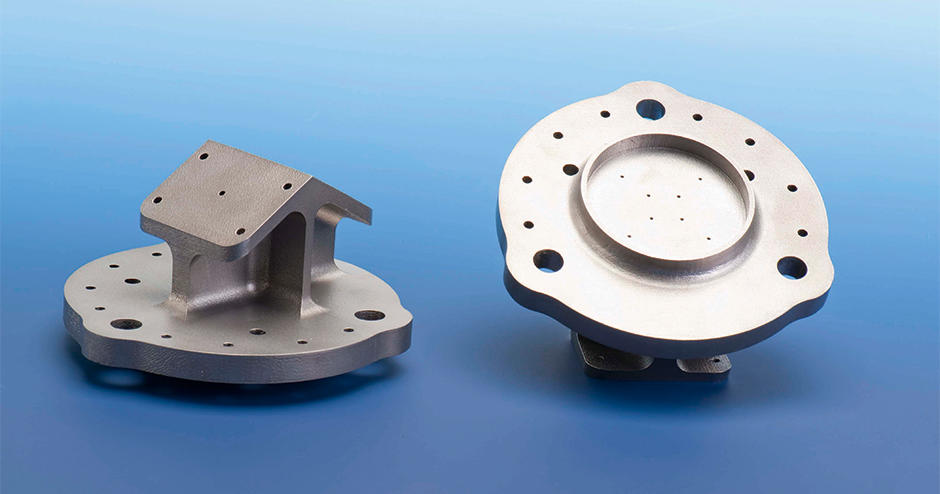European Space Agency is exploring the possibility of using 3D printing with metals

In the framework of cooperation with the European Space Agency (ESA), 3D Systems, with the active participation of its individual parts manufacturing unit, produces nozzles, combustion chambers and expanding nozzles for communication satellite engines operating on two-component fuels using 3D metal printing ( DMP) .

Injector line grown on a 3D printer of the DMP Series from 3D Systems
These details give ESA the opportunity to assess the potential for further improvements in manufacturing technologies for existing structures. In addition, ESA and 3D Systems experts use the capabilities of DMP technology to develop design options with shared functions for the aforementioned parts of satellite engines. It is, for example, a monolithic design of the combustion chamber, including a thin-walled pressure vessel with an external reinforcing mesh structure. DMP technology allows you to reduce weight, simplify assembly, speed up production and easily make design changes in the later stages of design. The collaboration with ESA is in line with 3D Systems' strategy to introduce its unique know-how to improve production technology in the space and aerospace industries.
Current state of 3D metal printing technology
Communication satellites are necessary for the operation of mobile Internet and secure financial communication between banks, direct TV broadcasting and Earth observation for weather forecasting. One of ESA's tasks is to oversee the development of space satellite engine manufacturing technologies. As part of its own-financed program, ESA explores the current state of 3D metal printing technology, evaluates its potential and maturity in the light of future engine developments.

Analysis of the image in x-rays with a resolution of 130 μm allows us to conclude that DMP technology can be effectively used for the manufacture of nozzles
As part of its research program, ESA selected 3D Systems, given its rich technological experience and level of customer support. 3D Systems implemented the design solutions for three critical parts, as well as their alternatives using DMP technology.
In the nozzle of the satellite engine there is a controlled mixing of two types of fuel, their spontaneous ignition and continuous combustion. In the combustion chamber in the form of a venturi, the gaseous products of combustion receive acceleration, placing the satellite in the desired orbit. The expanding nozzle affects the motion characteristics by acting on the gas flow.
“DMP technology provides the ability to manufacture an innovative line to optimize flow from the fuel valve to the combustion chamber,” says Simon Hyde. The freedom of design inherent in this method allows ESA to reduce the number of nozzle parts from five (using traditional manufacturing techniques) to one. In addition, many unsafe sealing joints are eliminated, which ensure reliable fuel injection, and significantly reduces the cost of manufacture and reduces risks. 3D Systems managed to create homogeneous structures with a relative density of up to 99.98%, which will allow the use of an increasing number of metals and alloys , including titanium.
Innovative nozzle line
3D metal printing technology is also suitable for thermal calculation of the nozzle, which prevents heat from leaking back to the sensitive seats of the fuel valves and to the spacecraft itself. The absence of restrictions on the access of the tool allows you to change the design of thermal insulation, controlling the thermal conductivity due to the reinforcing mesh structure. The nozzle parts made of an aircraft titanium alloy (Ti6Al4V) generally meet the requirements of the space sector and the rocket engine designer to ensure product quality.
Simon Hyde, European Space Agency, an innovative line made using 3D metal printing technology that optimizes fuel flow between the valve and the combustion chamber
Separation of combustion chamber functions
Combustion chambers of a compact satellite engine usually consist of a supersonic nozzle and the nozzle exit without mounting. Fuel reactions end in the tapering section, from where the gaseous products of combustion through the neck fall into the supercritical section, where they expand at a supersonic speed. Modern cameras are designed to withstand non-operational loads associated with startup - these transient loads are perceived by the thick walls of the chamber. After putting into orbit and with a workload, the cameras do not need such thick walls.

The separation of the functions of the combustion chamber between the working and non-working design loads leads to the need to use a compression frame supporting a thin wall
According to Simon Hyde, DMP technology allows you to split the camera functions between working and non-working load modes. An obvious solution is to create a compression frame made of ribs supporting a thin wall of the combustion chamber and a welding flange for attaching the outlet nozzle. However, instead of a primitive frame, 3D Systems manufactured a supporting structure in the form of a low-density mesh. Since its bulk density is only 12%, the use of DMP technology can significantly reduce the weight of the combustion chamber or increase the margin of safety of the structure.
Currently, the camera is made of titanium alloy Ti6Al4V. In the future, it is planned to produce it from a refractory alloy (for example, based on niobium, molybdenum, tantalum, tungsten and / or rhenium) so that it can withstand ultra-high fuel combustion temperatures. Further study of this revolutionary design of the combustion chamber involves the study of the grid isotropy in the stress field, as well as a detailed thermal analysis. The grid will increase the effective surface radiation, so it will undoubtedly affect the heat fluxes around the camera.
3D printing of large metal parts

Enhanced design capabilities made it possible to create a low-density grid on a radiating surface supporting a thin wall of the engine’s combustion chamber
. ESA engineers also investigated the possibility of using DMP technology to produce an output nozzle with an outlet diameter of up to 50 cm. At the time of the project’s implementation, DMP technology allowed printing products dimensions up to 275 x 275 x 450 mm. The stresses in the nozzle are relatively low, and a decrease in the mass of the cantilever part of the nozzle is a critical factor in increasing the margin of safety of the engine. 3D Systems manufactures an outlet nozzle made of titanium alloy (Ti6Al4V), which mainly meets the mechanical and thermal requirements for expanding outlet nozzles.
Hyde says DMP technology offers explicitAdvantages in production in comparison with traditional rotational extrusion of sheet material, which excludes any flexibility in design. It allows you to adapt the technical characteristics of the engine to the specific requirements of the customer to the traction profile, making it possible to change many decisions at the latest stages of design.
Translation from English. The original of this material is on the 3D Systems website.
